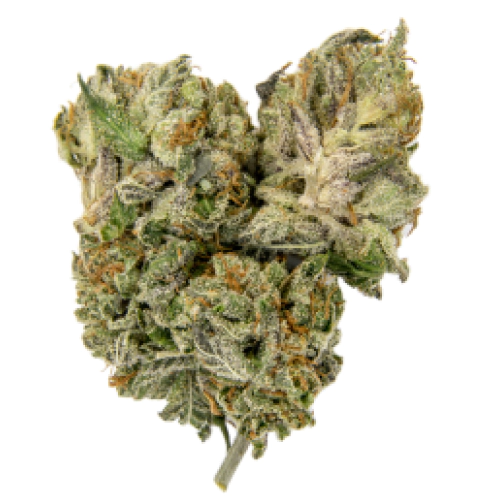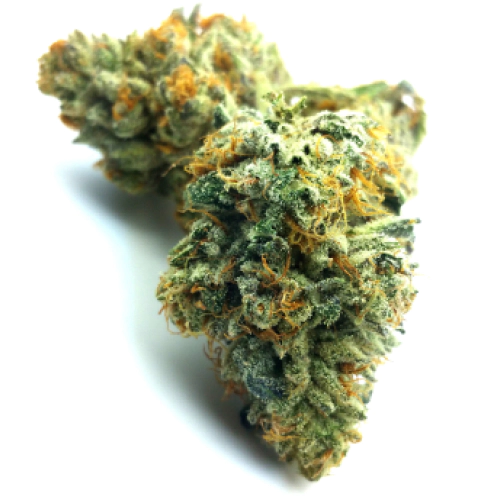THC 32 - 33.67%
CBD 0.12 - 0.26%
Effect Relaxed
Flavor Spicyherbal
15 - 23%
0.08 - 0.29%
0.08 - 0.28%
Coffee, Sweet
Giggly
Junior Mints strain is a cannabis hybrid where Indica genetics is slightly dominant. The Indica/Sativa ratio is 60/40. People can come across cuts with different THC concentrations depending on the breeder. This level can vary greatly, ranging from 15% to 23% and making it suitable for users with any THC tolerance. So, novices and veterans should check this information in dispensaries.
The CBD content in this weed is ridiculously low (0.08-0.29%); however, the plant contains other cannabinoids that help serve various medicinal purposes:
The Junior Mints strain smells of sweet coffee with nutty notes. Also, it reveals a kick of sharp menthol-like smells and flavors on closer inspection, which is not surprising since this kush was named for the iconic candy. This refreshing aroma is not cool but sweet and accompanied by lemon and honey notes. These odors are a characteristic of particular terpenes – linalool, caryophyllene, and myrcene.
The effects provided by this pot are sociable and enable free-flowing conversations. Smokers will feel euphoric, outgoing, and ready to chat with anyone around them. As their mood lifts to new heights of happiness, people will experience waves of giggles.
The wide-ranging effects offered by Junior Mints are helpful for medical MMJ patients. Its steady euphoria can be a temporary antidote to depression and stress. Also, the strain helps combat arthritis and muscle spasms.
This cannabis has few side effects, with two of them being commonly experienced by smokers – tingles and dizziness. Dry eyes and thirst are also typical but can easily be countered by staying hydrated. Less common reactions include:
Sensitive users are recommended to experiment with small doses of the Junior Mints strain to gauge the effect on their bodies.
The 55/61-day flowering period is highly desired by impatient growers who want to get their crop as soon as possible. The time for harvest is 61 days after germination. Junior Mints can easily be grown both inside and outside, though the harvest will vary. Indoors, gardeners can expect 1-2 ounces of dried flowers per 1 ft2 planted area. The same plants will produce 10-15 oz./plant in an outdoor grow. They develop fat grape-shaped nugs with purple undertones.
One big plus with this marijuana is that it doesn’t grow particularly tall (just 30-60 inches), so you don’t need to top the branches to keep the height under control. It is ideal for limited indoor spaces.
| THC | Tetrahydrocannabinol, or THC, is a major cannabis chemical compound. It is a psychoactive element that stimulates dopamine release and induces euphoria or happiness. THC-rich strains may be helpful with such conditions as lack of appetite, chronic pains , etc. It is considered to be the primary active marijuana component. | 15 - 23% |
| CBD | Cannabidiol, or CBD, is a major compound in cannabis, which is non-psychoactive. It is also proved to counteract the side effects of the second major component THC. CBD is widely used for medicinal purposes in rubs, oils and so on. It is helpful in muscle pain cases, may treat arthritis and migraines. Even Greeks used it against pain, while Queen Victoria applied it to get rid of menstrual cramps. | 0.08 - 0.29% |
| CBC | Cannabichromene, or CBC, is a minor cannabinoid, meaning that its quantity in cannabis is quite little. Though it has the same origin as CBD and THC, it is different in functions. Without any psychoactive effects, it is an efficient cannabis compound in combating acne and depression. CBC produces analgesic, antibacterial and anti-inflammatory effects. | 0.16 - 0.18% |
| CBG | Cannabigerol, or CBG, is one of the minor cannabis compounds in adult plants. On the other hand, young ones contain a lot of this antibacterial and anti-inflammatory component. During the growth, CBG is converted into different cannabinoids, mostly THC and CBD. The compound itself increases appetite and decreases eye pressure. | 0.08 - 0.28% |
| CBN | Cannabinol, or CBN, is a trace element in cannabis that is considered to be mildly psychoactive. It appears from oxidation THC, exposed to light and heat. CBN is mostly contained in old cannabis and in traditional hashish. It is effective against insomnia, bacterial infections and appetite loss. | 0.16 - 0.24% |
| THCV | Tetrahydrocannabivarin, or THC-V, is a compound contained in cannabis in trace amounts. Even though it is close to THC molecularly, it is different in effects. This compound may be psychoactive only in large amounts. THC-V reduces blood sugar, controls appetite, stimulates bone growth, etc. African Sativa strains are the richest in THC-V. | 0.04 - 0.12% |
| Myrcene | Myrcene (also known as β-myrcene) is one of the most common terpenes found in cannabis, representing more than 20% of the modern marijuana terpene profile. Myrcene has a distinct earthy, musky flavor, resembling cloves. It is responsible for calming and soothing effects of weed. Myrcene is also found in hops, thyme, mango, lemongrass, guava melon. | 0.19% |
| Limonene | Limonene (also known as d-limonene) is the second most common terpene in nature and the third most common terpene in cannabis. It has a powerful citrus aroma and can be found in all citruses, including lemons, oranges, grapefruits, limes, juniper, etc. Limonene is known to elevate moods and provide anxiety, depression, and stress relief. | 0.12% |
| Linalool | Linalool (also known as beta linalool, linalyl alcohol, linaloyl oxide, and p-linalool) is one of the rarest terpenes found in cannabis, mostly in small quantities. Linalool is known for its spicy and lavender aroma, bringing relaxation and calming effects. It is also said to provide anti-inflammatory and analgesic properties that can be useful for athletes. | 0.28% |
| Bisabolol | Bisabolol (also known as α-Bisabolol or levomenol) is a lesser-known terpene found in cannabis. It contributes to anti-inflammatory, anti-irritant, antioxidant, anti-microbial, and analgesic properties of weed strains containing bisanol. Attentive smokers would be able to catch a nutty, fruity scent with herbal and floral undertones, with a tender trace of coconut. | 0.11% |
| Eucalyptol | Eucalyptol (also known as cineole) is usually found in eucalyptus, mint, sage, and tea tree oil. Distinguished for its cooling properties, eucalyptol constitutes only up 0.6% of a total terpene profile of a strain. This terpene exhibits potent antibacterial effects and can also be used to treat patients with Alzheimer's disease and asthma. | 0.04% |
| Phellandrene | Phellandrene (also known as alpha- and beta-phellandrene) is one of the rare terpenes found in cannabis with antihyperalgesic and antidepressive properties. Phellandrene contributes to a minty, woody, and mildly citrus aroma in cannabis. Previously confused with limonene and pinene, phellandrene was eventually distinguished as a separate terpene common for eucalyptus. Also, it could be found in mint, dill, black pepper, cinnamon, parsley, pine, and lavender. | 0.02% |
| Caryophyllene | Caryophyllene (also known as beta or b caryophyllene) is a terpene found in many herbs and spices, such as black pepper, basil, rosemary, and oregano. Cannabis high in caryophyllene delivers a strong spicy, peppery aroma, resembling cinnamon and cloves. Caryophyllene offers potent anti-inflammatory and sedative effects. | 0.24% |
| Total terpenes content | 1.00% |
THC 32 - 33.67%
CBD 0.12 - 0.26%
Effect Relaxed
Flavor Spicyherbal
THC 15 - 18.25%
CBD 0.47 - 0.79%
Effect Uplifted
Flavor Citrus
THC 12.21 - 15.55%
CBD 0.44 - 1.17%
Effect Sleepy
Flavor Menthol

THC 18 - 21%
CBD 0.15 - 0.75%
Effect Calm
Flavor Earthy
THC 19 - 22.5%
CBD 0.3 - 0.96%
Effect Euphoric
Flavor Ammonia

THC 1 - 2.25%
CBD 15.57 - 21.87%
Effect Sleepy
Flavor Skunk
THC 17 - 24%
CBD 0.01 - 0.01%
Effect Calm
Flavor Mint
THC 22 - 26.5%
CBD 0.22 - 0.84%
Effect Uplifted
Flavor Pungent
THC 14.4 - 16.2%
CBD 0.18 - 0.46%
Effect Sleepy
Flavor Sweet
THC 20 - 27%
CBD 0.37 - 0.5%
Effect Tingly
Flavor Tropical
THC 16.6 - 19%
CBD 0.46 - 0.83%
Effect Sleepy
Flavor Sweet
THC 21.5 - 22%
CBD 0.2 - 0.34%
Effect Tingly
Flavor Spicyherbal

THC 13.33 - 16.67%
CBD 1.12 - 1.6%
Effect Happy
Flavor Pungent
THC 16 - 7%
CBD 0.14 - 0.9%
Effect Hungry
Flavor Vanilla
THC 18 - 19%
CBD 0.86 - 0.96%
Effect Euphoric
Flavor Lemon
THC 21 - 25.5%
CBD 0.46 - 0.72%
Effect Tingly
Flavor Sweet
THC 20 - 21.5%
CBD 0.75 - 1.12%
Effect Euphoric
Flavor Grape
THC 13.48 - 16.49%
CBD 0.02 - 0.29%
Effect Calm
Flavor Butter

THC 20 - 23%
CBD 0.38 - 0.49%
Effect Sleepy
Flavor Earthy
Be the first and share your opinion
Write a Review